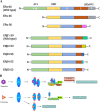The race to develop oral SERDs and other novel estrogen receptor inhibitors: recent clinical trial results and impact on treatment options
- PMID: 36229710
- PMCID: PMC9560885
- DOI: 10.1007/s10555-022-10066-y
The race to develop oral SERDs and other novel estrogen receptor inhibitors: recent clinical trial results and impact on treatment options
Abstract
Hormonal therapy plays a vital part in the treatment of estrogen receptor-positive (ER +) breast cancer. ER can be activated in a ligand-dependent and independent manner. Currently available ER-targeting agents include selective estrogen receptor modulators (SERMs), selective estrogen receptor degraders (SERDs), and aromatase inhibitors (AIs). Estrogen receptor mutation (ESR1 mutation) is one of the common mechanisms by which breast cancer becomes resistant to additional therapies from SERMs or AIs. These tumors remain sensitive to SERDs such as fulvestrant. Fulvestrant is limited in clinical utilization by its intramuscular formulation and once-monthly injection in large volumes. Oral SERDs are being rapidly developed to replace fulvestrant with the potential of higher efficacy and lower toxicities. Elacestrant is the first oral SERD that went through a randomized phase III trial showing increased efficacy, especially in tumors bearing ESR1 mutation, and good tolerability. Two other oral SERDs recently failed to achieve the primary endpoints of longer progression-free survival (PFS). They targeted tumors previously treated with several lines of prior therapies untested for ESR1 mutation. Initial clinical trial data demonstrated that tumors without the ESR1 mutation are less likely to benefit from the SERDs and may still respond to SERMs or AIs, including tumors previously exposed to hormonal therapy. Testing for ESR1 mutation in ongoing clinical trials and in hormonal therapy for breast cancer is highly recommended. Novel protein degradation technologies such as proteolysis-targeting chimera (PROTACS), molecular glue degrader (MGD), and lysosome-targeting chimeras (LYTACS) may result in more efficient ER degradation, while ribonuclease-targeting chimeras (RIBOTAC) and small interfering RNA (siRNA) may inhibit the production of ER protein.
Keywords: Aptamers; Clinical trials; LYTAC; Oral SERDs; PROTC; Protein degradation; RIBOTAC; Selective estrogen receptor degraders.
© 2022. The Author(s).
Conflict of interest statement
The authors declare no competing interests.
Figures




Similar articles
-
Novel oral selective estrogen receptor degraders (SERDs) to target hormone receptor positive breast cancer: elacestrant as the poster-child.Expert Rev Anticancer Ther. 2024 Jun;24(6):397-405. doi: 10.1080/14737140.2024.2346188. Epub 2024 Apr 26. Expert Rev Anticancer Ther. 2024. PMID: 38642015 Review.
-
Oral SERDs changing the scenery in hormone receptor positive breast cancer, a comprehensive review.Cancer Treat Rev. 2024 Nov;130:102825. doi: 10.1016/j.ctrv.2024.102825. Epub 2024 Sep 11. Cancer Treat Rev. 2024. PMID: 39293125 Review.
-
Selective Estrogen Receptor Degraders (SERDs): A Promising Strategy for Estrogen Receptor Positive Endocrine-Resistant Breast Cancer.J Med Chem. 2020 Dec 24;63(24):15094-15114. doi: 10.1021/acs.jmedchem.0c00913. Epub 2020 Nov 2. J Med Chem. 2020. PMID: 33138369
-
Oral Selective Estrogen Receptor Degraders (SERDs) in Breast Cancer: Advances, Challenges, and Current Status.Drug Des Devel Ther. 2022 Sep 2;16:2933-2948. doi: 10.2147/DDDT.S380925. eCollection 2022. Drug Des Devel Ther. 2022. PMID: 36081610 Free PMC article. Review.
-
Pharmacological insights on novel oral selective estrogen receptor degraders in breast cancer.Eur J Pharmacol. 2024 Apr 15;969:176424. doi: 10.1016/j.ejphar.2024.176424. Epub 2024 Feb 23. Eur J Pharmacol. 2024. PMID: 38402929 Review.
Cited by
-
ESR1 Gene Mutations and Liquid Biopsy in ER-Positive Breast Cancers: A Small Step Forward, a Giant Leap for Personalization of Endocrine Therapy?Cancers (Basel). 2023 Oct 27;15(21):5169. doi: 10.3390/cancers15215169. Cancers (Basel). 2023. PMID: 37958343 Free PMC article. Review.
-
A bibliometric analysis of metastatic breast cancer: two-decade report (2002-2022).Front Oncol. 2023 Aug 24;13:1229222. doi: 10.3389/fonc.2023.1229222. eCollection 2023. Front Oncol. 2023. PMID: 37692861 Free PMC article.
-
Optimizing selective estrogen receptor degraders for anticancer drug development.Future Med Chem. 2025 Mar;17(6):637-640. doi: 10.1080/17568919.2025.2467615. Epub 2025 Feb 26. Future Med Chem. 2025. PMID: 40008677 No abstract available.
-
Oral SERD, a Novel Endocrine Therapy for Estrogen Receptor-Positive Breast Cancer.Cancers (Basel). 2024 Jan 31;16(3):619. doi: 10.3390/cancers16030619. Cancers (Basel). 2024. PMID: 38339371 Free PMC article. Review.
-
Targeted protein degradation: advances in drug discovery and clinical practice.Signal Transduct Target Ther. 2024 Nov 6;9(1):308. doi: 10.1038/s41392-024-02004-x. Signal Transduct Target Ther. 2024. PMID: 39500878 Free PMC article. Review.
References
-
- Siegel RL, Miller KD, Fuchs HE, Jemal A. Cancer statistics, 2021. CA: A Cancer Journal for Clinicians. 2021;71(1):7–33. - PubMed
-
- Howlader N NA, Krapcho M, Garshell J, Miller D, Altekruse SF, Kosary CL, Yu M, Ruhl J, Tatalovich Z, Mariotto A, Lewis DR, Chen HS, Feuer EJ, Cronin KA (eds). . SEER Cancer Statistics Review, 1975–2011, National Cancer Institute. Bethesda, MD, https://seer.cancer.gov/archive/csr/1975_2011/, based on November 2013 SEER data submission, posted to the SEER web site, April 2014.
Publication types
MeSH terms
Substances
LinkOut - more resources
Full Text Sources
Other Literature Sources
Medical
Miscellaneous

